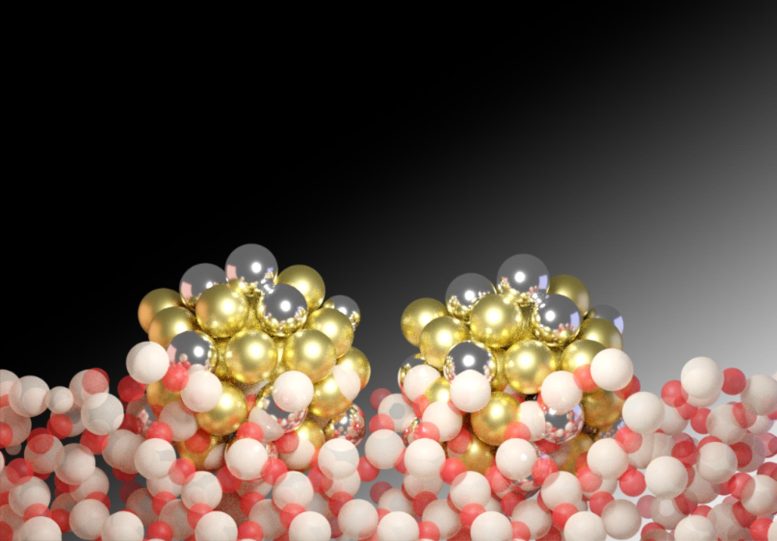Butterfly Wings Inspire Breakthrough in Catalyst Design
By
New research inspired by the intricate structure of butterfly wings has led to a method for fine-tuning catalytic reactions, enhancing selectivity and efficiency in chemical production. This breakthrough underscores the potential for bioinspired designs to drive industrial innovation. Credit: SciTechDaily.com
Researchers expand ways to improve the selectivity of catalytic reactions.
Researchers from the Harvard John A. Paulson School of Engineering and Applied Sciences (SEAS), Harvard Department of Chemistry & Chemical Biology, and Utrecht University have reported on a previously elusive way to improve the selectivity of catalytic reactions, adding a new method of increasing the efficacy of catalysts for a potentially wide range of applications in various industries including pharmaceuticals, cosmetics and much more.
The research will be published today (February 16) in Nature Catalysis.
Challenges in Catalytic Processes
The chemical industry relies on catalysts for over 90 percent of its processes and nearly all these catalysts consist of nanoparticles dispersed on top of a substrate. Researchers have long suspected that the size of individual nanoparticles and the distance between them play important roles in the speed of, and the products produced in the catalytic reaction, but because nanoparticles are prone to moving around and agglomerating during catalysis, it’s been difficult to study exactly how.
Over the past decade, Joanna Aizenberg, the Amy Smith Berylson Professor of Materials Science and Professor of Chemistry & Chemical Biology, and her lab have been drawing inspiration from nature to build highly ordered, porous materials for a wide range of catalytic reactions. Inspired by the structure of butterfly wings, the researchers designed a new catalyst platform that partially embeds nanoparticles into the substrate, trapping them so they don’t move around during catalysis, while leaving the rest of the nanoparticles’ surface exposed, enabling them to perform the catalytic reactions efficiently and without agglomeration.

Smaller average interparticle distance. Gold, silver, white, and red spheres represent gold, palladium, Silicon, and oxygen atoms, respectively. Credit: Harvard SEAS, edited
Enhancing Reaction Selectivity
The researchers found that the distance between particles had a huge impact on the selectivity of the reaction.
“Many industrially-relevant chemical reactions follow a cascade whereby chemical A is turned to chemical B which can then be turned into chemical C and so forth,” said Kang Rui Garrick Lim, a graduate student in the Aizenberg Lab and first author of the study. “In some catalytic processes, the intermediate chemical, chemical B, is the goal, while in others it is the end product, chemical C. The selectivity of the catalyst refers to whether it favors the production of chemical B or chemical C.”
A good example of this is the production of benzyl alcohol, a chemical used in everything from shellacs, paints, and leather production to intravenous medications, cosmetics, and topical drugs.
Benzyl alcohol is the intermediate chemical B, derived from the hydrogenation of benzaldehyde (chemical A), before the reaction creates toluene (chemical C), another commonly used chemical but of lower value. In order to produce benzyl alcohol efficiently, the formation of toluene needs to be suppressed.
Currently, to make the more useful benzyl alcohol, the catalytic hydrogenation reaction is slowed down, or not run to completion, to ensure that the reaction will stop at B and form as little toluene as possible.
“Generally, to make these intermediate chemicals, you make the catalyst less reactive and the overall reaction slower, which is not productive at all,” said Lim. “Catalysts are meant to speed things up, not slow them down.”
Implications and Future Directions
The researchers demonstrated their platform in the catalytic formation of benzyl alcohol. Lim and the team found that when catalytic metal nanoparticles were placed further apart on the substrate, the reaction was more selective towards benzyl alcohol, the intermediate chemical. When the nanoparticles were closer together, the reaction was more selective towards toluene, the end product. Given that the distance between nanoparticles can be adjusted synthetically using the bioinspired catalyst platform, the research suggests that the same catalyst platform can be easily adapted for a range of intermediate or end-product chemicals.
“Catalysis is central to the production of a whole range of extremely important materials that are used in pharmaceuticals, consumer products, and in manufacturing many products all of us use in everyday life,” said Aizenberg.
“Adding this selectivity-improving tool to the chemist’s arsenal is extremely important. It will allow more effective tuning of catalytic processes, more economical use of the feedstocks accompanied by the reduction of energy consumption and waste generation. We hope that chemists will use our platform in further optimization of new and existing catalytic processes.”
Next, the team will use the same platform to understand how the size of nanoparticles impacts the reaction at fixed distances between nanoparticles.
Reference: 16 February 2024, Nature Catalysis.
DOI: 10.1038/s41929-023-01104-1
Harvard’s Office of Technology Development has protected the intellectual property of Professor Aizenberg’s lab, which is the underlying technology of this research.
The research was co-authored by Selina K. Kaiser, Haichao Wu, Sadhya Garg, Marta Perxes Perich, Jessi E. S. van der Hoeven and Michael Aizenberg. It was supported in part by the Integrated Mesoscale Architectures for Sustainable Catalysis (IMASC), an Energy Frontier Research Center funded by the US Department of Energy, Office of Science, Basic Energy Sciences under award number DE-SC0012573 and by the US Defense Threat Reduction Agency (DTRA) under award number HDTR1211001612.
By

New research inspired by the intricate structure of butterfly wings has led to a method for fine-tuning catalytic reactions, enhancing selectivity and efficiency in chemical production. This breakthrough underscores the potential for bioinspired designs to drive industrial innovation. Credit: SciTechDaily.com
Researchers expand ways to improve the selectivity of catalytic reactions.
Researchers from the Harvard John A. Paulson School of Engineering and Applied Sciences (SEAS), Harvard Department of Chemistry & Chemical Biology, and Utrecht University have reported on a previously elusive way to improve the selectivity of catalytic reactions, adding a new method of increasing the efficacy of catalysts for a potentially wide range of applications in various industries including pharmaceuticals, cosmetics and much more.
The research will be published today (February 16) in Nature Catalysis.
Challenges in Catalytic Processes
The chemical industry relies on catalysts for over 90 percent of its processes and nearly all these catalysts consist of nanoparticles dispersed on top of a substrate. Researchers have long suspected that the size of individual nanoparticles and the distance between them play important roles in the speed of, and the products produced in the catalytic reaction, but because nanoparticles are prone to moving around and agglomerating during catalysis, it’s been difficult to study exactly how.
Over the past decade, Joanna Aizenberg, the Amy Smith Berylson Professor of Materials Science and Professor of Chemistry & Chemical Biology, and her lab have been drawing inspiration from nature to build highly ordered, porous materials for a wide range of catalytic reactions. Inspired by the structure of butterfly wings, the researchers designed a new catalyst platform that partially embeds nanoparticles into the substrate, trapping them so they don’t move around during catalysis, while leaving the rest of the nanoparticles’ surface exposed, enabling them to perform the catalytic reactions efficiently and without agglomeration.

Smaller average interparticle distance. Gold, silver, white, and red spheres represent gold, palladium, Silicon, and oxygen atoms, respectively. Credit: Harvard SEAS, edited
Enhancing Reaction Selectivity
The researchers found that the distance between particles had a huge impact on the selectivity of the reaction.
“Many industrially-relevant chemical reactions follow a cascade whereby chemical A is turned to chemical B which can then be turned into chemical C and so forth,” said Kang Rui Garrick Lim, a graduate student in the Aizenberg Lab and first author of the study. “In some catalytic processes, the intermediate chemical, chemical B, is the goal, while in others it is the end product, chemical C. The selectivity of the catalyst refers to whether it favors the production of chemical B or chemical C.”
A good example of this is the production of benzyl alcohol, a chemical used in everything from shellacs, paints, and leather production to intravenous medications, cosmetics, and topical drugs.
Benzyl alcohol is the intermediate chemical B, derived from the hydrogenation of benzaldehyde (chemical A), before the reaction creates toluene (chemical C), another commonly used chemical but of lower value. In order to produce benzyl alcohol efficiently, the formation of toluene needs to be suppressed.
Currently, to make the more useful benzyl alcohol, the catalytic hydrogenation reaction is slowed down, or not run to completion, to ensure that the reaction will stop at B and form as little toluene as possible.
“Generally, to make these intermediate chemicals, you make the catalyst less reactive and the overall reaction slower, which is not productive at all,” said Lim. “Catalysts are meant to speed things up, not slow them down.”
Implications and Future Directions
The researchers demonstrated their platform in the catalytic formation of benzyl alcohol. Lim and the team found that when catalytic metal nanoparticles were placed further apart on the substrate, the reaction was more selective towards benzyl alcohol, the intermediate chemical. When the nanoparticles were closer together, the reaction was more selective towards toluene, the end product. Given that the distance between nanoparticles can be adjusted synthetically using the bioinspired catalyst platform, the research suggests that the same catalyst platform can be easily adapted for a range of intermediate or end-product chemicals.
“Catalysis is central to the production of a whole range of extremely important materials that are used in pharmaceuticals, consumer products, and in manufacturing many products all of us use in everyday life,” said Aizenberg.
“Adding this selectivity-improving tool to the chemist’s arsenal is extremely important. It will allow more effective tuning of catalytic processes, more economical use of the feedstocks accompanied by the reduction of energy consumption and waste generation. We hope that chemists will use our platform in further optimization of new and existing catalytic processes.”
Next, the team will use the same platform to understand how the size of nanoparticles impacts the reaction at fixed distances between nanoparticles.
Reference: 16 February 2024, Nature Catalysis.
DOI: 10.1038/s41929-023-01104-1
Harvard’s Office of Technology Development has protected the intellectual property of Professor Aizenberg’s lab, which is the underlying technology of this research.
The research was co-authored by Selina K. Kaiser, Haichao Wu, Sadhya Garg, Marta Perxes Perich, Jessi E. S. van der Hoeven and Michael Aizenberg. It was supported in part by the Integrated Mesoscale Architectures for Sustainable Catalysis (IMASC), an Energy Frontier Research Center funded by the US Department of Energy, Office of Science, Basic Energy Sciences under award number DE-SC0012573 and by the US Defense Threat Reduction Agency (DTRA) under award number HDTR1211001612.
